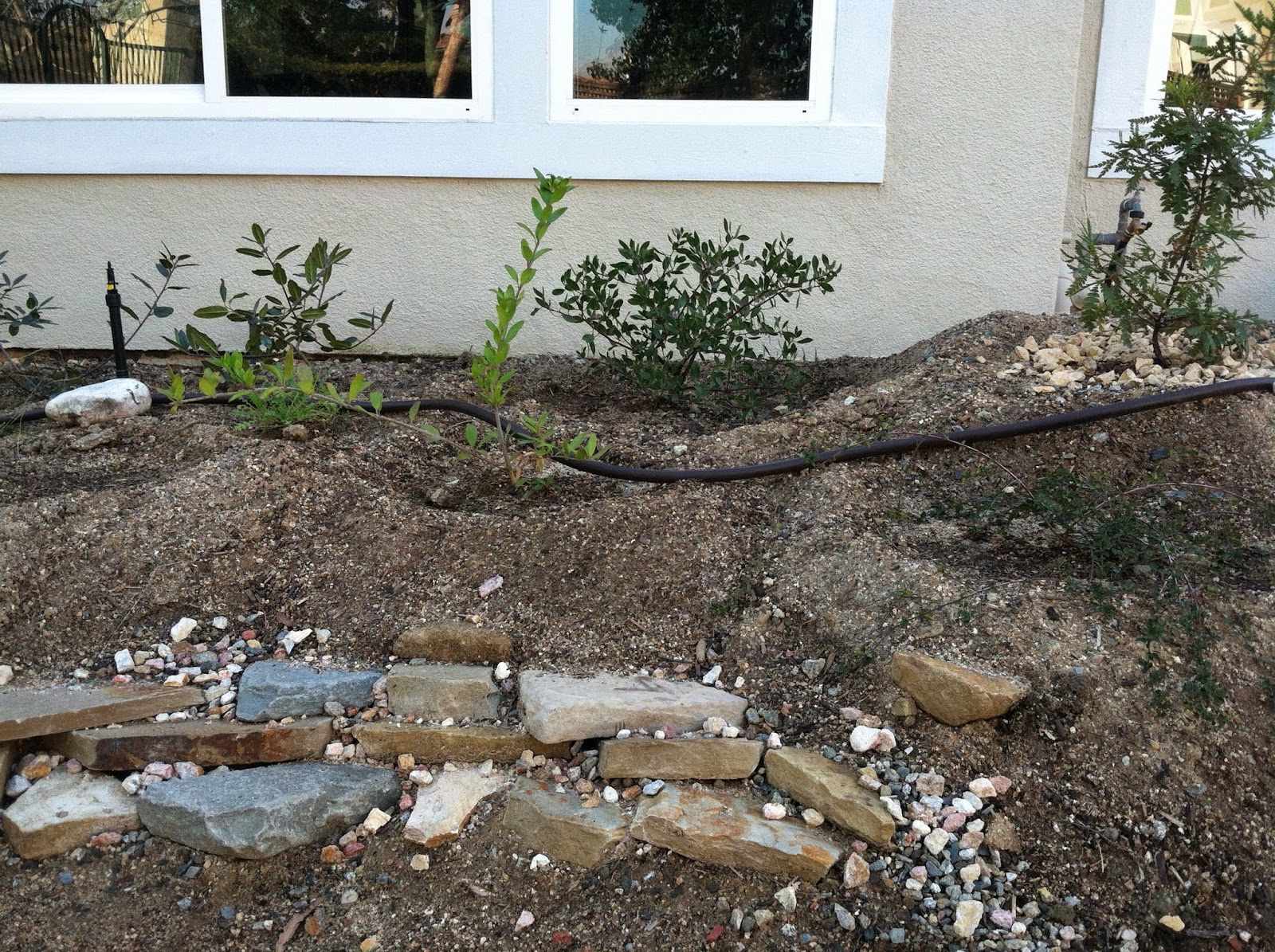Foolproof addition to any native garden: rocks! Any native garden can benefit aesthetically by the addition of rocks. If you worry that you have a black thumb, be artful with rocks. They never die.
 |
Rocks inconspicuously holding a soil mound in place,
giving CA woodland strawberries a context in my garden. |
Good news: native gardens don't require you to remove rocks (or amend soil either.) That painstaking work would be just about impossible in some parts of California. I added lots of rocks to my garden, both for aesthetics and to prop up all my mounded sandy soil.
 |
| When my garden was new, rocks provided interest the tiny plants could not. |
Rocks need to be partially buried to look natural. Otherwise they look like somebody dumped random rocks in your garden. My landscape architect friend
Cheryl Fields showed me how to make rock terraces that look somewhat natural, to add interest and stability to my mounded sandy soil.
 |
The same rock ledge at planting and two years after.
Festooned with growth in January, this ledge reveals itself again
in summer when the strawberries and poppies die back. |
La Pilitas Nursery recommends big rocks as "mulch" for natives, saying that each plant needs its (pet) rock around 6" in diameter. If you look at the hills around Las Pilitas South (Escondido), the rock-to-plant ratio is far greater than one-to-one.
 |
| Rocky trail with white Ceanothus in Escondido. |
Rocks help keep the soil cool and preserve moisture without encouraging rot as regular mulch could do. They give bugs a place to hide. (Native garden: home for bugs. Bugs feed birds. In a healthy garden, bugs will not devour your plants.)
 |
Rocks add ambiance in the beer garden at Stone Brewery in Escondido.
I can't picture the equipment they used to install those puppies. |
You might think rocks are a low-budget way to fill in a new garden that is looking bare. You might be wrong. At the local building supply yard, I can buy lovely rocks of all shapes and sizes, for 10 to 30 cents a pound. That adds up shockingly fast. Also the good-sized ones will break your back. You'd be surprised how small a rock requires a front-end loader to move. That sends the price right up.
 |
This is a big rock.
Big enough to get two strong men sweating. |
I inherited two big rocks as part of my yard's otherwise useless landscaping when I moved (in 1995). Scott and Tomaz pushed and pulled this one about ten feet using a cardboard "sled" and every bit of their considerable combined muscle. Knowing what they cost and how hard they are to move, I now appreciate those rocks fully.
 |
| Cone in garden: not a feature. |
Once I wanted to keep people from driving over (and breaking) sprinklers at the edge of a church parking lot, so I asked at the building supply yard which biggish rocks were cheapest. I ended up with pumice: volcanic rock with air bubbles in it. It worked fine, and was easier to move than more expensive rocks too. A vast aesthetic improvement over the "borrowed" orange traffic cones the church had been using for several years!
The low-budget option is of course to collect your own rocks. This is surprisingly hard to do (legally) in Orange County; what little land isn't developed is protected parkland. So whenever I take a road trip, I pick up a few rocks along the way. Not the ones that would kill gas mileage, just a little something. I'd like to say I could tell you where each rock came from, like my BIL Robert. No way. I'm told they come up occasionally on Craigslist for free too.
My young neighbor Elijan carves our neighborhood sandstone (salvaged from construction grading). I bought one of his creations. I know where that rock came from! He would be happy to sell you one; let me know.
 |
Elijan's handiwork from local sandstone.
It's varnished and seems to be holding up well. |
If you dream of creating a native garden, start collecting your rocks now.
If you wish to subscribe to this CA Native Garden blog,
click here.
If you wish to use photos or text from this blog,
click here.
To subscribe to this blog,
click here.
To use text or photos from this blog,
click here.
To share this post (do share!) click on the appropriate tiny icon below (email, facebook, etc.)














I found the overview provided here quite helpful for getting up to speed on this subject. Some of your analysis lined up with how I've been thinking about it as well. At the same time, a few aspects were new information for me too. Thanks for taking the time to outline the key issues in an approachable way.
ReplyDeleteplastic tarpaulin
Nice Blogs Buddy
ReplyDeleteHeavy Duty tarpaulin
This was a very informative and interesting read. You’ve covered all the bases and provided a balanced perspective. Great work!
ReplyDeletetarpaulins
Nice Post Visit US
ReplyDeleteOutdoor Rock Installation South Kelowna
Outdoor Rock Setup Installation in Lake Country